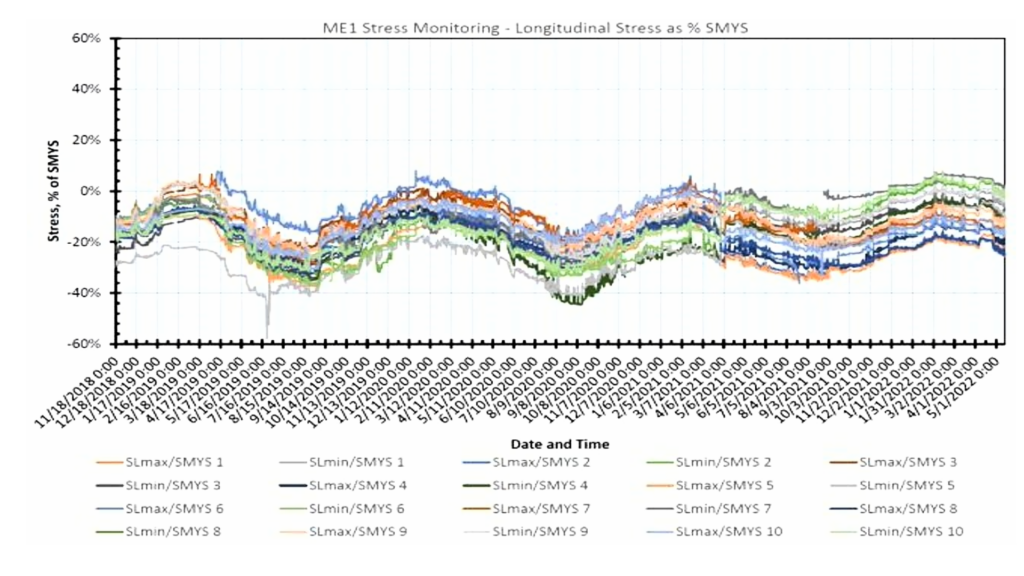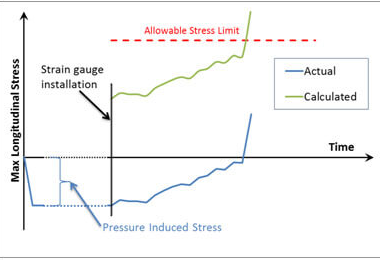Geo-Hazard Monitoring of Pipelines using Strain Gauges

Table of Contents:
- Introduction
- Stress near Pipe Bends and Exposed Pipelines
- The Issue with Preexisting Stress Direction
- Predicting Preexisting Stresses
Introduction
Pipelines are sometimes subjected to geo-hazards, such as long wall mining subsidence and slope movement. A commonly practiced method to reduce stress in such situations is to expose the affected portion of a pipeline. Monitoring stress in an affected pipeline is necessary for a proper remedial plan. However, strain gauges can only measure the changes in the strain at the time of installation. An exposed pipeline has preexisting stresses from differential temperature and internal pressure (‘pre-existing’ in the context of this note means stresses prior to installing strain gauges). ASME B31 limits are based on total and equivalent stress values. Therefore, the stress calculations should include pre-existing stresses and stress biaxiality (effect of hoop stress).
Preexisting stresses are usually estimated based on simplifying assumptions and added to the measured stresses from strain gauges to calculate total stress. Preexisting stresses from pressure are usually assumed to be tensile, while thermal stresses are usually included only when they increase the total stresses. However, these assumptions sometimes lead to complexities and confusion with unwanted consequences. In this article, a common issue related to pipe internal pressure (and sometimes negative differential temperature) is discussed, and methods to avoid it are explained.
Stress near Pipe Bends and Exposed Pipelines
Exposing a pipeline by excavating soil cover removes longitudinal and, to some extent, lateral restraints from around the pipe. As a result (with some exceptions), thermal stress is due to positive temperature differentials between the time of pipeline installation and the time the monitoring is performed. This is because the pipeline can move sideways to release compression from a positive differential temperature that tends to elongate the pipe. Depending on the amount of sag in a pipeline, a negative differential temperature may or may not create significant bending stress near pipe bends. On the other hand, internal pressure usually induces significant stress at and near the bends of an exposed pipeline. Pressure tends to create tension in the longitudinal direction, creating an effect similar to a negative differential temperature. However, internal pressure also affects the pipe curvatures (thrust force and Bordon’s effect). Regardless of the amount of sag in a pipeline, this effect can generate significant stress, particularly along induction bends in hilly terrain.
The Issue with Preexisting Stress Direction

Pressure (or temperature) induced stresses near bends are primarily bending, and depending on the circumferential location, they can be compressive or tensile. The issue arises when the direction of ground movement-induced stress (tensile vs. compressive) is opposite to preexisting stresses from pressure (or temperature). Still, the stress engineer, not knowing the actual stress, conservatively assumes they have the same direction. The figure above schematically shows this problem.
In this figure, the preexisting stress from pressure at a gauge location is compressive, while the ground-induced stress has a tensile trend (and the opposite is true at the opposite clock position of the pipe cross-section). Therefore, the actual stress decreases with ground movement. However, the calculations assume the preexisting stress is tensile because the actual direction is unknown. As a result, it appears that the stress in the pipe is increasing. As the stress approaches the limit (red line), the operator may decide to shut in the pipeline, but to their surprise, the stress increases even higher when the pressure is reduced! The author has experienced this issue several times in actual monitoring projects where decreasing pipe pressure was associated with an apparent increase in stress. The lesson is that preexisting stress should be determined realistically. At a minimum, an attempt should be made to predict the direction of preexisting stresses.
Predicting Preexisting Stresses
One method to estimate preexisting stresses is through finite element analysis (FEA) prior to strain gauge installation. Longitudinal stresses are very sensitive to actual sag in a pipeline, which usually cannot be determined easily. However, a proper FEA can usually predict directions (tension versus compressive) of pre-existing stresses at various clock positions. A more direct method is to lower and then increase the pipe’s internal pressure and monitor the gauges during the resulting pressure cycle. Then, gauge responses can be extrapolated to a zero-pressure condition to determine pressure-induced stresses. Due to the potential interference of nonlinear effects, larger pressure cycles are preferred, although practical restrictions may limit the amplitude of the pressure change. When construction documents of a pipeline contain ambient temperature records or at least construction season, a similar test can be performed on differential temperature, but this time more conveniently because every exposed pipeline experiences daily cycles of temperature. Therefore, normal operation does not need to be interrupted. All that is needed is a monitoring system that can measure and report pipe surface temperatures along with strains at an adequate frequency (e.g., every 30 minutes) throughout the day.

